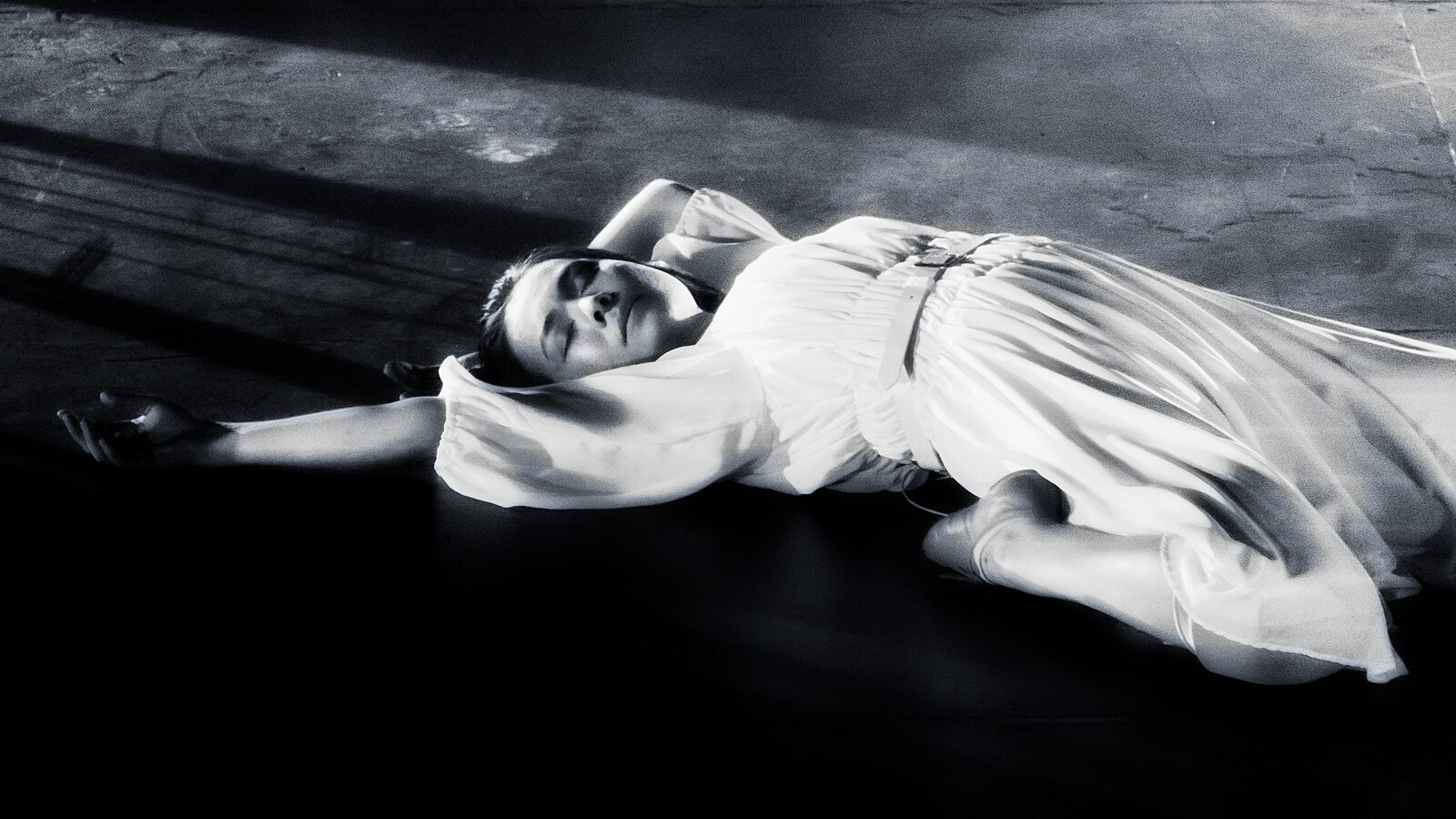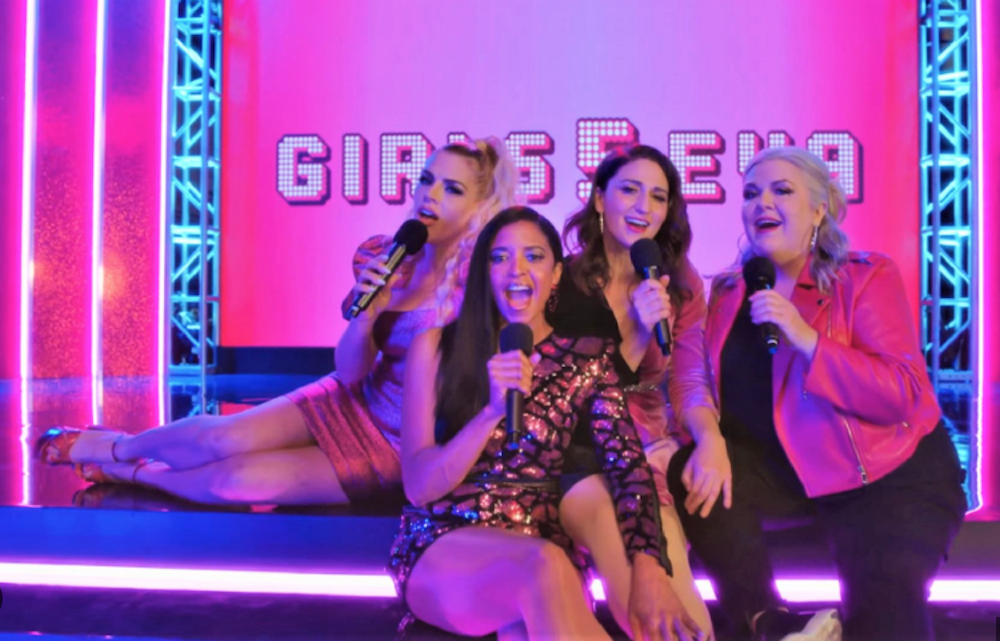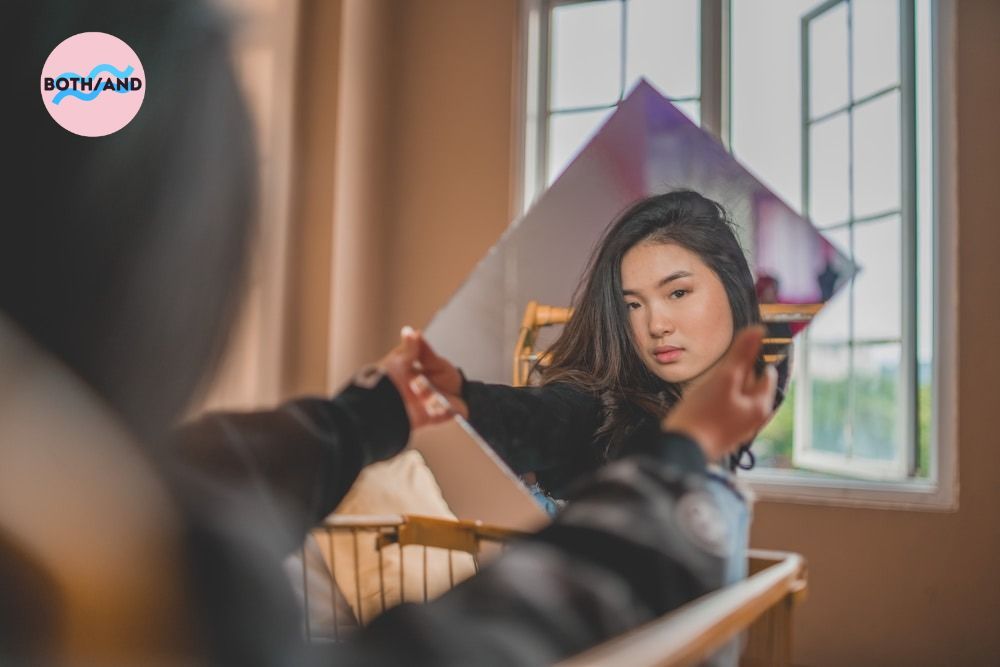Books & Culture
Can Mitski and Her Stans Save American Theater?
Instead of reprimanding stan culture, it might be time for theaters to embrace it

It was a clear, cold night in February when my wife and I took our seats in the sold-out Beacon Theatre to await what would be the most creative one woman show we had seen since Edinburgh Fringe last summer.
Earsplitting screams peeled out into the air as the performer coolly took the stage, meeting the crowd’s crazed energy with a deliberate, powerful calm. This act of tempering was a prologue; the artist then disappeared behind a draped curtain that glowed bright white, casting her in a silhouette. She lifted her arms to create the shape of long horns, evoking antiquity, and marched slowly toward us, her shadow growing until it stretched from floor to ceiling. Dionysus, the body said, We invite you, god of theater, to this space.
A young attendee, iPhone in hand, exclaimed, “She’s wilin’!”
When Mitski reemerged from behind the curtain, she had slipped into the mask of Performer.
Mitski’s This Land is Inhospitable and So Are We show is an orange dreamscape filled with Americana syrup, punctuated by past hits like soliloquies of remembered yearning. Her movement through each number is a curation inspired by Butoh, Grotowski, Bob Fosse, and likely a whole host of other artists I don’t know about.
It’s not a concert, nor is it theater; it’s something in between, and her audience reflects that. I could divide the vibe like a pie: one third sitting in silent awe, one third sitting in concentration, and one third screeching. There was a dash of attention seeking as well; one person yelled “Hydrate!” every time Mitski took a sip of water.
It’s not a concert, nor is it theater; it’s something in between, and her audience reflects that.
This is not the first time Mitski has incorporated choreographed dance inspired by various theatrical forms; in 2018, to get out from behind her pink guitar in a way that felt natural, she began a collaboration with multimedia performance artist and choreographer Monica Mirabile. Six years later, the duo launched the This Land Is Inhospitable and So Are We tour into new theatrical heights, not only in production caliber but in the venues themselves, half of which are seated spaces. This new arrangement seems to say, “Now sit down and shut the fuck up respectfully enjoy the show.”
The set is a circular, elevated platform, complete with two simple chairs. Working in tandem with this simplicity is the complex and wildly imaginative lighting design that creates everything from a hot pink rain shower to a cage to a single spotlight engaged in a cat-and-mouse chase with Mitski, evoking her need of, and aversion to, performance. The band sprawls around the upstage wing, similar to the staging of the bands in Hadestown and Waitress, which are both fully visible and part of the act, but deliberately off-center.
Fancy tech is not a uniquely Mitski thing. Flashy projections and synchronized lighting is commonplace at concerts these days, but Mitski’s production designs function more as a narrative vehicle than an agent for holding attention. This is a fitting choice; Mitski is currently working on the music for the upcoming Queen’s Gambit musical, and I can’t help but to think that the connections made there may be influencing her, even boosting her tech team with Broadway’s finest backstage minds.
Despite the hecklers, and the signs on the walls that stated this was a device-free show, no eagle-eyed Broadway usher reprimanded the disruptors or the recorders. At no point did Mitski acknowledge her 2022 request that fans not record whole sets, nor did she ask the crowd to put their phones down. And she could have – on the boygenius tour, Phoebe Bridgers asked fans to not record her performance of “Letter to an Old Poet,” and I am a two-time eyewitness that they obeyed. Mitski’s strategy was a bit more abstract. “We are all going to die,” she reminded us, “So knowing that, what are you going to do with the time that you have?” The question was rhetorical, but I’ll take a stab at an answer: be in the moment.
Theater exists to remind us of the human condition; that life is imperfect and fleeting. Playwrights love to remind people that they’re going to die, to inspire a new way of moving through life. Mitski is doing just that, for a demographic of young fans who are statistically not attending live theater.
Four rambunctious youths sat a few rows in front of us. They were mostly self-contained, until Mitski did “I Bet on Losing Dogs,” wherein they lost their shit, their voices tearing through the ballad like a pack of baby dinosaurs. Their phones were on the whole time, but I don’t know why; from my vantage point, it looked like half of their footage was of the Beacon’s ceiling.
By the end of the show, they’d calmed. The benefit to a seated space is that disruptive fans can’t hide. There is no crowd to slink away in or tall body to crouch behind. By the time Mitski got to “Bug Like an Angel,” the loudest of the group muffled her squawk, earning a wave of sympathetic laughter.
Mitski’s nontraditional approach to musical performance is teaching a generation of non-theater-goers the experience of attending live theater. She prolongs gestures, dances with chairs, holds silence long enough for the audience to taste suspense.
The American Theatre is on life support. This could be a radical treatment.
The current Mitski tour, extended through June 6th and picking back up on August 27th, is not a concert, but an extravagant one-woman show. This is great for theater, but perhaps not for the reasons Mitski might hope. Seeing young people consume her performance and share it widely begged the question: What if instead of complaining about ‘bad audience behavior,’ we encouraged stan culture in the theater space?
When millennials were young, and social media was not a scourge on society but a chance for innovation, one regional theater tried to harness its potential. At the start of 2012, D.C.’s Woolly Mammoth Theatre Company tried a “tweet seats” event, encouraging a select few audience members to live tweet during their performance of Civilization (all you can eat). This experiment ruffled the feathers of director Jason Grote, who had not been informed of these plans, sparking a conversation about theater etiquette.
“[‘Civilization’] is written in a style [that] requires a certain degree of listening and concentration,” Grote said, stating that he wouldn’t stop the marketing team, but he wouldn’t be silent about it either (he took his complaints to Twitter). “The whole strength of something like Twitter is that it can’t be controlled. You get quick, shallow impressions from a large sample of people. In the context of a new play, that can be a bit delicate…”
What if we were to restart this experiment, intentionally chasing the chaos of shallow impressions and uncontrollable virality – the same beast that launched Mitski’s song ‘Nobody’ into millions of listens on TikTok and Spotify? I might be as deranged as the young women who like to meow at Mitski performances, but I think an argument could be made for not policing phones during performances. The American Theatre is on life support. This could be a radical treatment.
Six months ago, my wife and I were at the Edinburgh Fringe Festival with our one woman show Modern Witches. Lassoing audiences to attend our show – one of 3,535 – was a rollercoaster of blind hope and ego death. Modern Witches was, by all accounts, a success: we never had to cancel for lack of audience. Yet every post-show high was followed by the same morning-after anxiety, which came in the form of a question: Do we have an audience tonight?
The Fringe is supposed to be the place where clowns, solo shows, and other experimental artists can find audiences, yet this hope is a dimming light, lost to unaffordable short-term housing and the big venues’ trend of promoting their high-budget, flashy acts and celebrities that are guaranteed to sell tickets.
To heal from the daily pain of imploring strangers to pay attention to us, we would relax at the Blundagardens, a small venue off the beaten path known for its unique, micro venues that feature some of the Fringe’s most off-beat comedians and clown artists. The standup stage is the upper level of a double decker bus, the cabaret space a yurt. It is a haven for experimental theater.
I dragged my wife into the ‘Spiegeltent’ on a few occasions, including our last night of the Fringe, when Blundagardens co-producer and clown wizard Lucy Hopkins was slated to perform their Closing Ceremony.
Tightly packed like plums in a basket, it was easy to see that the majority of the audience were other Fringe artists like me: exhausted, and giddy with the prospect of retiring from the mental gymnastics required to perform for empty seats. First, we held a moment of silence for all our fellow artists who could not perform at Fringe because they could not afford to. Then, Lucy directed us to lob our grievances and insecurities into the soupy, sweaty air. Artists yelled, “Does anyone care?”, “Is it worth it?”, “Tired!”
Us fringe theater people know we’ve chosen a hard-to-sell profession. Young people have not considered experimental theater a hip thing since the 1960s, but if a show is interesting enough to get people talking, it will be a hit. Word of mouth is king, and it’s free. In our first week, my wife and I were implored by a friend to see a clown at 1:30 in the morning. He claimed that Ha Ha Ha Ha Ha Ha Ha, Julia Masli’s groundbreaking show, was the best theater he had ever seen, period. This discourse snowballed throughout the festival, earning her the title of Edinburgh’s “Breakout Clown,” according to the New York Times. What did she break out from? A crumbling festival system? The stench of her peers’ jealousy? A world that does not care about performance art?
Unlike broke ass Fringe performers, regional theaters have endowments. Yet even with these millions, they’re still struggling to convince audiences to buy tickets.
Even though there were phones, heckling, and screeches, our hearts still beat as one.
The few youths that are out there attending live, not-Broadway shows, practice word of mouth online. This generation has the power to reach more of itself – the very thing that dying regional theaters agonize over reaching. If theaters were to invite recording into the space, would it be as bad as we think? On one hand, it might be. Audiences and actors alike might hate it. Like Mitski said, we’re there to share in the magic of the live moment. Theater exists to create this; it is one of the last artistic spaces to do so.
But on the other hand, none of that will matter if there’s no theater left to watch, save for exorbitantly-priced Broadway shows.
The idea that allowing phones in the theater will save it might sound like fantasy, but it’s already been attempted, and it worked. In the Interrobang Productions’ recent performance of Katie Hileman’s I Will Eat You Alive in Baltimore, which was staged as an immersive dinner party, the house speech confirmed that recording was okay, as long as flash was turned off. When asked why, producer Kiirstn Pagan said, “It just worked. We didn’t feel necessary to be precious about it. We want people to know about the show.” They sold out their final weekend of performances.
Dusty regional theaters could become launchpads for a new revolution of theater-goers. They just need to accept the way young people experience the world. The trend of complaining about bad behavior is as much a strategy to farm engagement as the kids remixing concert moments for virality – and that isn’t saving theater either.
As a theater artist at the Mitski show, six months out from the gauntlet of angst that was the Edinburgh Fringe, I found myself grinning at the young crowd and their volcanic excitement. They thought they were seeing wacky Mitski do her thing, but I knew the truth: we were tuned in to the primal rhythm of shared experience, celebrating clown work and chair choreography. Even though there were phones, heckling, and screeches, our hearts still beat as one. Maybe the youths – god help me – are not the problem.








